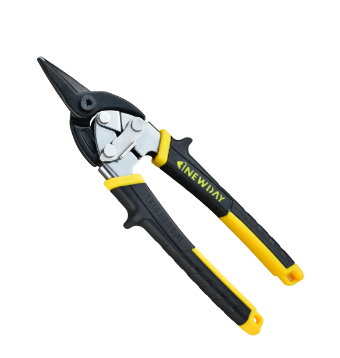Understanding Different Types of Electrician Shears
Choosing the right electricians shears is crucial, as they come in various types designed for specific tasks. If you're dealing with tough materials, heavy-duty shears are your best bet. These shears boast reinforced blades and robust construction, making them suitable for cutting through thick wires and cables, often found in industrial settings. Their durability is essential for long-term use in challenging environments. On the other hand, precision shears are ideal for delicate tasks, such as trimming wires or working in confined spaces. They are designed with finer blades that ensure clean cuts without damaging the materials, making them a must-have for technical and intricate work.
Transitioning from blade strength to blade design, the choice between angled and straight blade designs varies based on your cutting needs. Angled blade electrician shears improve visibility and grant better access to tight spots, which is essential when working overhead or on intricate installations. These shears allow for maneuvering in challenging positions without compromising efficiency. Meanwhile, straight blade electrician shears provide a versatile option for standard cutting tasks, offering clean cuts across various materials. They are a dependable choice for conditions where visibility is not much of a concern, ensuring efficiency and precision in routine cutting activities.
When dealing with specialized materials like fiber optics or cables, specific shears are necessary. Fiber optics shears are crafted to handle sensitive materials without causing damage, featuring fine sharp tips necessary for precise cuts that maintain the integrity of the optical fibers. Additionally, cable shears are designed to cope with larger and thicker cables. They often come with ergonomically designed grips that alleviate manual fatigue during extensive cutting sessions. This design not only enhances comfort but also maximizes cutting efficiency, making them indispensable for professionals managing voluminous cable tasks regularly.
By understanding these different types of electrician shears, we can make informed decisions that align with specific electrical projects and ensure our tools meet our precise needs efficiently.
Key Features to Evaluate When Choosing Shears
Blade Material: Stainless Steel vs. Carbon Steel
When choosing electrician's shears, one critical feature to consider is the blade material. Stainless steel blades are renowned for their resistance to corrosion. This makes them ideal for electricians working in diverse environments where the tools may be exposed to moisture or chemicals. Stainless steel shears maintain sharpness over time, offering durability and reliability in various tasks. On the other hand, carbon steel blades tend to be sharper initially, providing precise cuts. However, they require careful maintenance to prevent rust and degradation. Regular cleaning and oiling must be ensured to maintain their effectiveness, as neglect might lead to compromised performance.
Cutting Capacity and Serrated Edges
Another essential feature to evaluate is the cutting capacity of the shears. This refers to the thickness of materials the shears can effectively cut through, crucial in determining their suitability for your specific needs. Electricians must select shears that match the range of materials they'll encounter, whether it be wires, cables, or other components. Additionally, serrated edges on blades can enhance grip, especially useful when cutting slippery materials. This feature provides a more controlled cutting experience, preventing slippage and enabling precision even in challenging conditions.
Spring Mechanisms for Reduced Hand Fatigue
Spring mechanisms in electrician's shears are vital for those intending to use the tool for extended periods. These mechanisms assist in the opening and closing process, reducing strain and fatigue on the hands. This user-friendly feature significantly impacts the performance and efficiency of the electrician's tasks, especially when numerous repeated cuts are required. By reducing the effort needed to operate the shears, spring mechanisms help maintain productivity and comfort, allowing electricians to focus on the task at hand without the constant distraction of physical discomfort.
Ergonomics and Handle Design for Comfort
Non-Slip Grip Materials
When working with electrician shears, choosing tools with non-slip grip materials like rubber or textured plastic can significantly improve your control over the tool. These materials provide a reliable grip even in wet or oily conditions, ensuring safety and precision during use. This is crucial for electricians who often engage in delicate tasks, where accuracy is paramount. The use of non-slip grip materials on electrician shears enhances user confidence and efficiency, making it a vital feature to look for when selecting the right shears.
Handle Shape and Weight Distribution
The shape of the handle plays a critical role in the comfort and efficiency of electrician shears. Ergonomically designed handles are crafted to fit naturally in your hand, which reduces strain and enhances maneuverability during extended use. Additionally, appropriate weight distribution is essential to balance the shears, allowing for prolonged use without causing excessive fatigue. Whether you are handling routine or complex operations, having well-designed handles ensures that your shears are not only comfortable to use but also highly functional for various cutting tasks.
Adjustable Tension for Customized Use
Having adjustable tension settings on your electrician shears allows for customization based on the task at hand. This feature is particularly beneficial when dealing with different material thicknesses, as it enables users to fine-tune the resistance according to their needs. Customization in tension settings ensures that the shears can adapt to various cutting demands, providing maximum effectiveness. This adaptability makes them a valuable tool for electricians who require precision and efficiency in their work.
Safety and Durability Considerations
Locking Mechanisms to Prevent Accidents
Locking mechanisms on shears are essential safety features that prevent accidental openings during transport or storage. These mechanisms are crucial in protecting users from potential injuries and ensuring that the blades remain closed and safe when not in use. This added security fosters user confidence, particularly in environments where safety is paramount. Electricians can focus on their tasks without the nagging worry of their tools unexpectedly opening. This innovation in electrician shears not only enhances safety but also contributes to the overall efficiency and reliability of the tools in professional settings.
Corrosion-Resistant Coatings
The inclusion of corrosion-resistant coatings on electrician shears is a proactive measure to shield blades from wear and tear, especially in humid or moist environments. These coatings are vital for electricians who frequently operate in challenging conditions. By extending the lifespan of the shears, they significantly reduce the need for constant replacements, thus offering both economic and practical benefits. Such durability ensures that the shears retain their cutting efficiency over time, allowing electricians to perform their duties with reliable tools that continue to function at optimal levels regardless of environmental factors.
Reinforced Joints for Long-Term Use
Reinforced joints in electrician shears enhance the durability and strength required for cutting through tough materials. These joints ensure that the shears withstand constant use and resist the stresses inflicted by demanding tasks. By investing in shears with high-quality reinforced joints, electricians can expect better long-term performance and reliability, essential traits for tools in regular and rigorous use. This not only improves the tool's lifespan but also contributes to safety, as sturdy joints reduce the risk of tool failure during critical operations. Overall, reinforced joints are a testament to the thoughtful engineering behind robust and dependable electrician shears.
Maintenance Tips for Optimal Performance
Cleaning and Lubrication Best Practices
Regular cleaning and lubrication are crucial for maintaining the performance of electrician shears. Keeping the shears clean prevents debris build-up that can cause rust and hinder cutting efficiency. To ensure optimal performance, it's vital to lubricate the pivot points of the shears. This practice not only enhances the smoothness of the cut but also prolongs the lifespan of the tool. By implementing these maintenance routines, the efficiency and durability of electrician shears are significantly improved, allowing for more reliable use on the job.
Sharpening Techniques for Precision Cuts
Maintaining sharp blades on electrician shears is essential for precision cuts. Utilizing a sharpening stone or specialized tools is an effective method to restore the edge of the blades. Experts emphasize the importance of scheduling regular sharpening sessions based on how frequently the shears are used. This consistency ensures that the shears perform at their best, providing clean and precise cuts every time. Regularly sharpening shears leads to better performance and can prevent blade damage over time.
Proper Storage to Avoid Blade Damage
Proper storage of electrician shears is necessary to avoid blade damage and ensure the safety of users. Keeping shears in a protective case or sheath prevents accidental dulling or damage to the blades. Such storage solutions safeguard against potential injuries from exposed blades as well. By properly storing electrician shears, both the longevity of the tools and the safety of the user are enhanced, making them a reliable asset for any electrician's toolkit.
FAQ
1. What are the different types of electrician shears available?
The different types of electrician shears include heavy-duty shears for thick wires, precision shears for delicate tasks, angled and straight blade shears, fiber optics shears, and cable shears.
2. How does blade material impact the performance of electrician shears?
Stainless steel blades are resistant to corrosion and maintain sharpness, while carbon steel blades offer initial sharpness but require maintenance to prevent rust and degradation.
3. Why are ergonomic handle designs important for electrician shears?
Ergonomically designed handles fit naturally in the hand, reducing strain and enhancing maneuverability, improving comfort and efficiency during extended use.
4. How often should I maintain my electrician shears?
Regular cleaning, lubrication, and sharpening should be conducted based on the frequency of use to maintain optimal performance and extend the lifespan of the shears.


